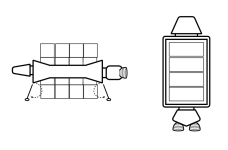Not to sidetrack your point (too much) ... but I'm personally coming around to the notion that for "austere" landing zones (wilderness, etc.) you honestly don't want to be trying to find a parking space for a starship over 100-200 tons displacement (starting with landing gear ground pressure considerations at unprepared landing locations). In a lot of cases, what you're really wanting to use for deliveries to "austere" landing zones is going to be a small craft carrying a standardized container.
Basically ... these ...
Modular Cutter
Modular Cutter Module
The smaller 50 ton craft can "get into and land" at more locations (safely) than an entire 100+ ton starship can, and a Modular Cutter has a 60% transport fraction (30 ton module in a 50 ton small craft). Those modules can be "quickly exchanged" allowing the Modular Cutter (the remaining 20 tons of it) to effectively be operated like a sort of "sky crane" in locations that offer effectively no ground support whatsoever.
Ideally speaking, you're going to want a pilot for your starship and another pilot for your small craft ... with sufficient maneuvering power to "geostationary park in low orbit" over the landing zone and then use the
Modular Cutter as an orbital interface shuttle for
Modular Cutter Module(s) anywhere on a surface under atmosphere. At 4G acceleration, one way trips from the surface to low orbit can be made in
minutes, for relatively rapid cycling between surface and orbit for fast delivery of containerized modules that are already loaded with everything you want to transfer (so just plug 'n' play).
So a 50 ton
Modular Cutter basically gives a ship the ability to deliver cargo loaded into a 30 ton
Modular Cutter Module to wilderness locations "safely" with a minimal amount of fuss or "exposure" for the parent starship. Depending on how covertly the delivery needs to be made, that can be an important consideration.
Case in point ... you can use a single
Modular Cutter to deliver (one by one) ~8-12
Modular Cutter Modules outfitted as a sealed environment fire base for a platoon of mechanized infantry and their vehicles, capable of sustaining operations for a substantial amount of time. From a mercenary unit perspective, that's a rather non-trivial capability ... especially if that fire base can be "packed up and withdrawn" to an orbital rendezvous point in a matter of hours. Likewise, such a fire base could essentially be "mobilized" to another point on a surface, simply by use of one
Modular Cutter gathering up the
Modular Cutter Modules loaded with all the gear and setting up shop elsewhere as a new base of operations.
So in terms of "backwater" locations play, I'm seeing a LOT of upside to spending "an 54 tons for 30 tons of cargo capacity" (for the small craft plus pilot stateroom) in order to be "liberated" from being tied down to ground facilities at starports when it comes to making deliveries "out in the boonies" on planets. However, note that as the capacity for additional modules goes up (2, 3, 4, 5+ modules carried) the "pay an extra 24 tons" fraction for that capability goes down, since you're "reusing" the small craft to deliver all of those modules in a "one small craft, many modules" operational paradigm.
Note that this is where "external cargo capacity" can start becoming an important factor in starship economics, when you have "excess drive capacity" above what you "need" to reach a particular destination, so you can "load up" on external attachments (like
Modular Cutter Modules loaded with "stuff") and use a
Modular Cutter (or equivalent) to make surface to surface deliveries of that external cargo load.


